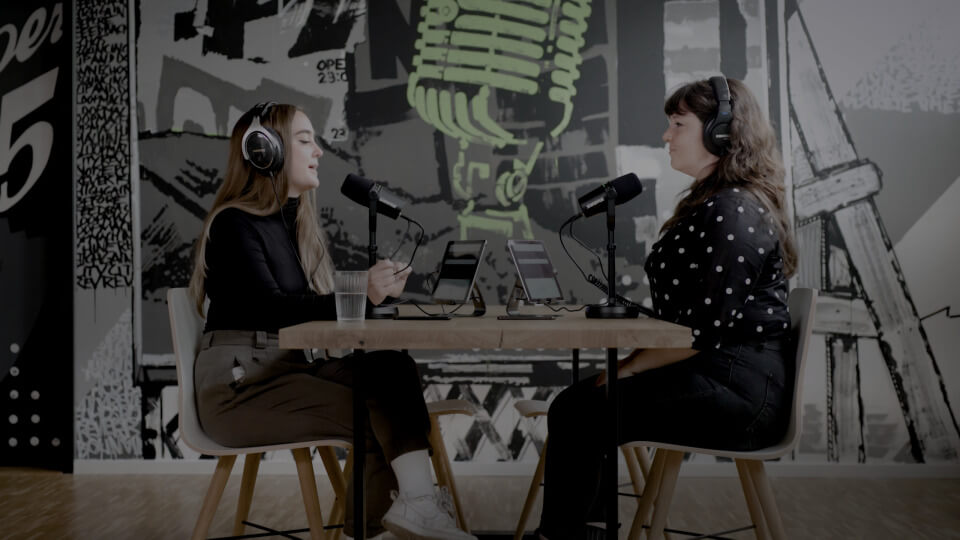Choosing a Best Podcast Microphone (2023)
By RG team · 8 min read
Last Updated on June 5, 2023
Wait a minute...

Introduction
Podcasting has become one of the most popular forms of online content, with millions of people tuning in every day to listen to their favorite shows. To ensure the success of your podcast, one of the most important things to consider is the quality of your audio. After all, if your listeners can't hear you clearly, they'll quickly lose interest and move on to something else. That's where choosing the right microphone comes in.
With so many different microphones available on the market, it can be challenging to know where to start. There are many factors to consider when choosing a podcast microphone, including microphone type, polar patterns, and frequency response. In this article, we'll take a closer look at the best podcast microphones for 2023. We'll also discuss some of the key features to consider when selecting a microphone and provide some tips on accessories that can help you get the most out of your mic.
Factors to Consider When Choosing a Podcast Microphone

Photo by Sebastian Pandelache on Unsplash
Selecting the right microphone for your podcast can have a significant impact on the quality of your audio. Here are some of the key factors to consider when choosing a podcast microphone:
Microphone Type
There are two main types of microphones: dynamic and condenser. Dynamic microphones are generally more rugged and durable and are well-suited for live performances and recording instruments. On the other hand, condenser microphones are more sensitive and are ideal for picking up vocals and other subtle sounds. For podcasting, condenser microphones are usually the best choice.
Polar Patterns
Polar patterns refer to the directionality of a microphone. There are three main types of polar patterns: omnidirectional, cardioid, and bidirectional. Omnidirectional microphones pick up sound from all directions, while cardioid microphones pick up sound primarily from the front of the mic. Bidirectional microphones pick up sound from both the front and back of the mic. For podcasting, a cardioid polar pattern is typically the best choice, as it helps to reduce background noise and focus on the speaker's voice.
Frequency Response
Frequency response refers to the range of sounds that a microphone can pick up. Generally speaking, the wider the frequency response, the more accurately the microphone can reproduce sounds. For podcasting, a microphone with a frequency response between 20Hz and 20kHz is usually sufficient.
By considering these factors, you can help to ensure that you choose a microphone that's well-suited to your podcasting needs.
Top Picks of Podcast Microphones for All Budgets

There are numerous microphones available that will produce excellent results for podcasting regardless of your budget. Here are some of the top picks for podcasting microphones in 2023.
Shure MV7 USB Podcast Microphone
The Shure MV7 USB Podcast Microphone is a great option for both beginners and experienced podcasters. It features both USB and XLR outputs, allowing you to connect it to a computer or mixer. Its dynamic cardioid polar pattern helps to reduce background noise, and its frequency response range is 50Hz to 16kHz.
Blue Yeti USB Microphone
The Blue Yeti USB Microphone is another excellent option. It has a USB output for direct connection to your computer, as well as a headphone jack for monitoring. Its adjustable polar patterns allow you to switch between cardioid, bidirectional, omnidirectional, and stereo modes. Its frequency response range is 20Hz to 20kHz.
Rode PodMic
The Rode PodMic is a durable, dynamic microphone that features a cardioid polar pattern. It's specifically designed for podcasting, and its internal shock mounting helps to minimize handling noise. Its frequency response range is 20Hz to 20kHz, and it features an integrated pop filter.
Shure SM7B Cardioid Dynamic Microphone
The Shure SM7B Cardioid Dynamic Microphone is widely considered to be one of the best microphones for podcasting. Its dynamic cardioid polar pattern helps to reduce background noise, and its frequency response range is 50Hz to 20kHz.
MAONO AU-A04 Condenser Microphone Kit
The MAONO AU-A04 Condenser Microphone Kit is an affordable option that still offers excellent sound quality. It features a cardioid polar pattern, and its frequency response range is 20Hz to 20kHz. The kit includes a shock mount, pop filter, and adjustable arm stand.
FIFINE Dynamic USB Podcast Mic
The FIFINE Dynamic USB Podcast Mic is a budget-friendly option that doesn't compromise on quality. It features a cardioid polar pattern and a frequency response range of 50Hz to 15kHz. Its internal pop filter helps to reduce plosives, and its built-in headphone jack allows for real-time monitoring.
By considering these top picks, you can ensure that you're choosing a high-quality microphone that's well-suited to your podcasting needs, regardless of your budget.
Honorable Mentions
While the microphones listed above are some of the best options available for podcasting, there are a few honorable mentions worth mentioning as well.
Rode Procaster
The Rode Procaster is a dynamic microphone with a frequency response range of 75Hz to 18kHz. It features a tight cardioid polar pattern and an internal shock mounting system to reduce handling noise. Its durable build quality and broadcast-quality sound make it an excellent option for podcasters.
Heil PR-40
The Heil PR-40 is another dynamic microphone that's popular for podcasting. It features a wide frequency response range of 28Hz to 18kHz, along with a cardioid polar pattern and low self-noise. Its internal shock mount reduces handling noise, and its durable construction makes it a long-lasting option.
Electro-Voice RE-20
The Electro-Voice RE-20 is a classic dynamic microphone that's been used in radio and podcasting for decades. It features a frequency response range of 45Hz to 18kHz and a cardioid polar pattern. Its variable-D design helps to minimize proximity effect, and its internal pop filter helps to reduce plosives.
While these microphones may not have made the top picks list, they're still excellent options to consider, depending on your podcasting needs.
Comparison of Popular Podcast Microphones
Here's a side-by-side comparison of some popular podcast microphones, showcasing their key features and prices to help you make an informed decision:
Microphone | Type | Polar Pattern | Frequency Response | Price |
|---|---|---|---|---|
Shure MV7 USB Podcast Microphone | Dynamic | Cardioid | 50Hz - 16kHz | Rs. 23,400 |
Blue Yeti USB Microphone | Condenser | Cardioid, Bidirectional, Omnidirectional, Stereo | 20Hz - 20kHz | Rs. 10,000 |
Rode PodMic | Dynamic | Cardioid | 20Hz - 20kHz | Rs. 8,000 |
Shure SM7B Cardioid Dynamic Microphone | Dynamic | Cardioid | 50Hz - 20kHz | Rs. 41,700 |
MAONO AU-A04 Condenser Microphone Kit | Condenser | Cardioid | 20Hz - 20kHz | Rs. 2,900 |
FIFINE Dynamic USB Podcast Mic | Dynamic | Cardioid | 50Hz - 15kHz | Rs. 5,900 |
As you can see, there's a wide range of microphones available at different price points and with different features. By comparing their key specifications, you can get a better understanding of which microphone is the best fit for your needs.
Accessories You'll Need for Your Podcast Microphone

While a high-quality microphone is essential for great podcast audio, there are a few accessories you'll need to get the most out of your microphone.
Pop Filter
A pop filter is a small, mesh screen that attaches in front of your microphone to prevent plosives - the popping sounds that can occur when saying words that start with the letters "p," "b," or "t." Pop filters are generally affordable and widely available, and they can be a game-changer for preventing unwanted sounds from making their way into your recordings.
Shock Mount
A shock mount is a device that cradles your microphone and isolates it from the stand or boom arm. By doing so, it helps to reduce handling noise and other sounds that can be picked up through the microphone. Shock mounts are especially useful for condenser microphones because they're much more sensitive than dynamic microphones.
Mic Stand
A mic stand is a necessary tool to hold your microphone steady while you record. Desk stands, boom arm stands, and tripod stands are all great options, depending on your physical setup. Boom arm stands are especially useful because they can be adjusted to move the microphone closer or further away from the source, and they take up minimal desk space.
By investing in these accessories for your podcast microphone, you can ensure that you're getting the best possible audio quality from your microphone.
Conclusion
Choosing the right microphone for your podcast is crucial for ensuring that your listeners can hear your audio with clarity and precision. By considering factors such as microphone type, polar patterns, and frequency response, you can make an informed decision when selecting a microphone. Our top picks for podcast microphones in 2023 include the Shure MV7 USB Podcast Microphone, Blue Yeti USB Microphone, Rode PodMic, Shure SM7B Cardioid Dynamic Microphone, MAONO AU-A04 Condenser Microphone Kit, and FIFINE Dynamic USB Podcast Mic. Honorable mentions include the Rode Procaster, Heil PR-40, and Electro-Voice RE20.
To get the most out of your microphone, you should also invest in accessories such as a pop filter, shock mount, and mic stand. By doing so, you can help to reduce unwanted sounds and ensure that your microphone is functioning at its best.
Ultimately, the right podcast microphone comes down to your individual needs, preferences, and budget. By using this guide as a starting point, you'll be well on your way to choosing a microphone that's perfect for your podcast.



